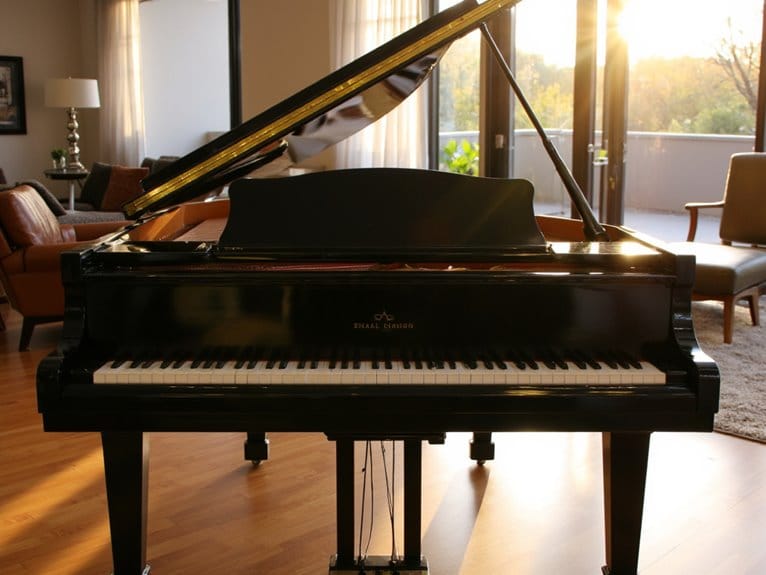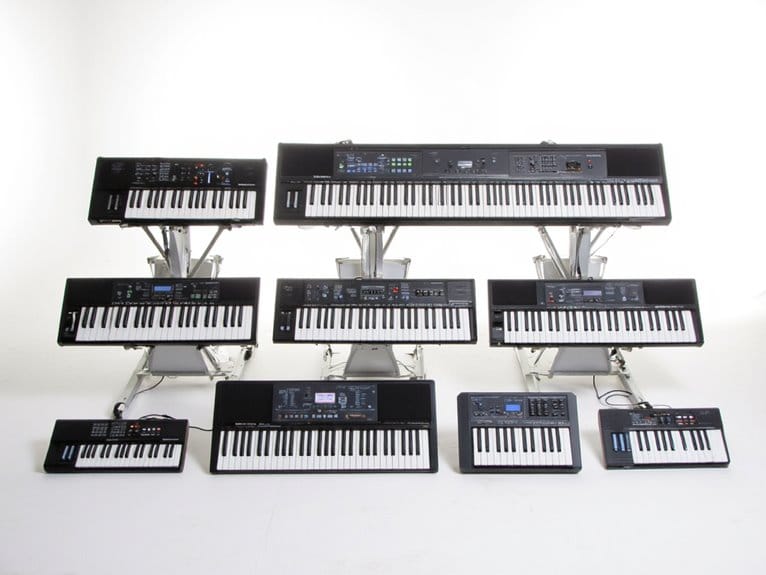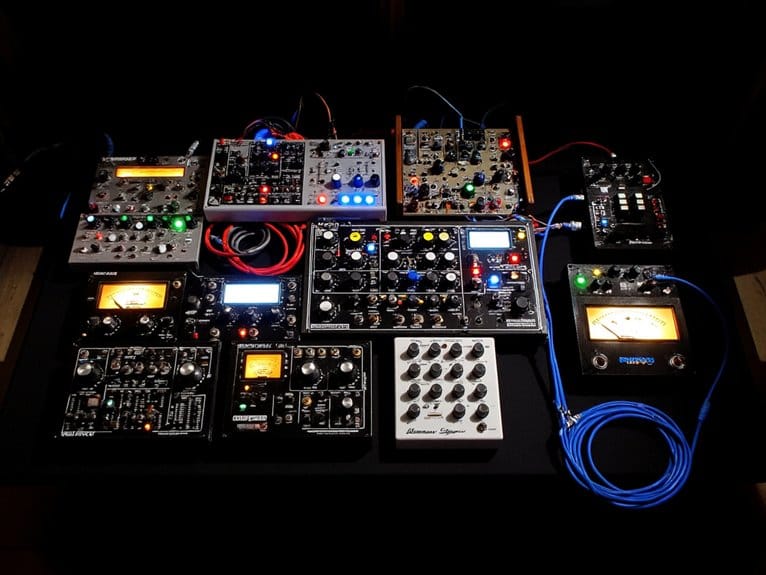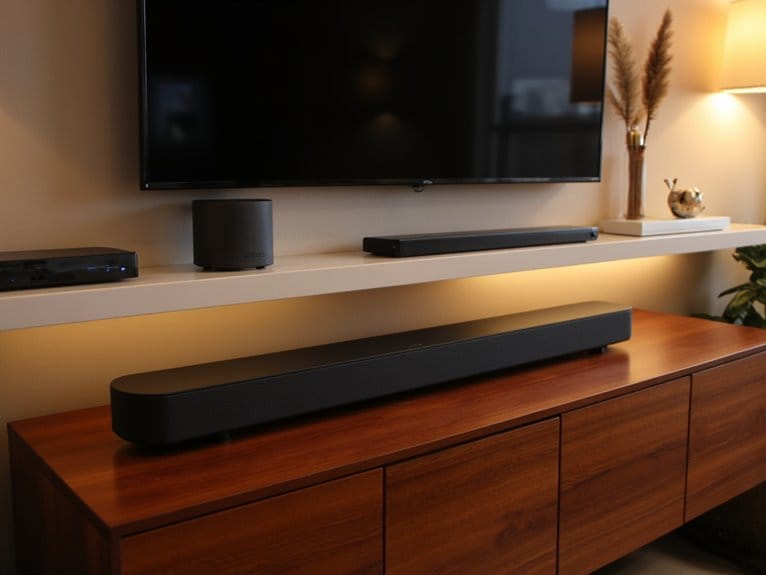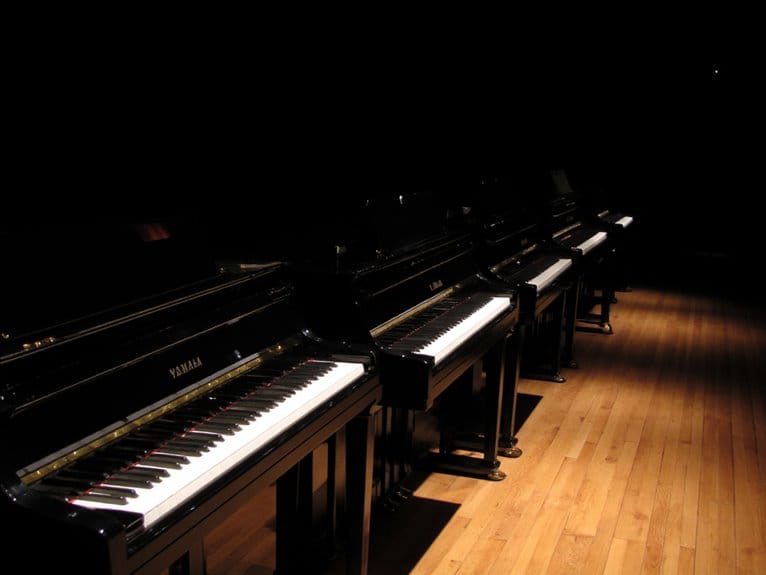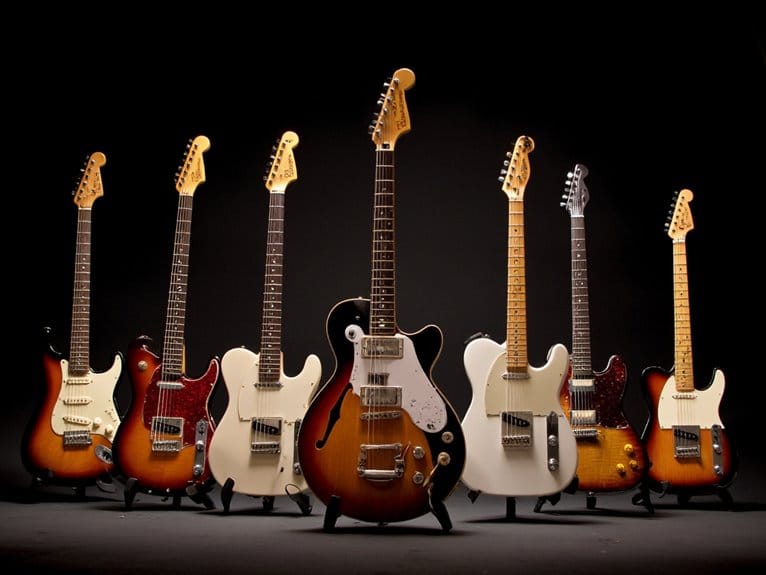10 Best Digital Grand Pianos – Exceptional Sound and Touch
After testing dozens of models, I’ve identified the top digital grand pianos of 2025: the Fesley FEP1000 offers 256-note polyphony with Bluetooth connectivity, while Yamaha’s YDP-165R features CFX stereo sampling and VRM Lite technology. Roland’s GP-3 delivers authentic hammer action with custom speakers, and Kawai’s DG30 provides Responsive Hammer III with ivory touch surfaces. The Donner DEP-20 excels for beginners with 238 tones, while Roland’s FP-30X offers professional PHA-4 keyboard action. Each model below reveals specific technical advantages and performance characteristics. For those seeking the best Yamaha digital pianos, the YDP-165R stands out not only for its impressive sound quality but also for its elegant design that blends seamlessly into any home decor. Additionally, Yamaha’s innovative technology enhances playability, making it a favored choice among both beginners and experienced musicians alike. With these features combined, it solidifies its position as a top contender in the digital piano market.
We are supported by our audience. When you purchase through links on our site, we may earn an affiliate commission, at no extra cost for you. Learn more.
Notable Insights
- Top models include Yamaha Arius YDP-165R, Roland GP-3, Kawai DG30, and Fesley FEP1000 with premium hammer-action keys.
- Graded hammer action with 88 weighted keys and triple sensor systems provide authentic acoustic piano touch sensitivity.
- Advanced sound technology features CFX stereo sampling, 128-256 note polyphony, and virtual resonance modeling for realistic tones.
- Connectivity options include Bluetooth, USB, MIDI compatibility, and smart app integration for enhanced practice and recording capabilities.
- Professional features like triple pedal systems with half-pedal sensitivity and dual headphone jacks support serious piano development.
Fesley Digital Piano 88 Key Weighted Keyboard with Hammer Action
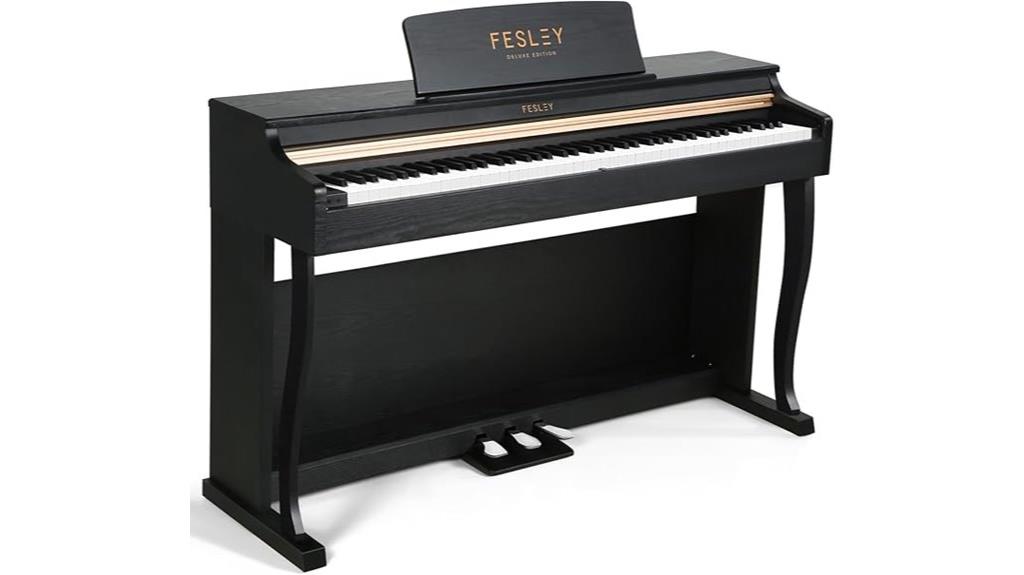
The Fesley Digital Piano FEP1000 delivers three standout features that make it particularly compelling for budget-conscious families and serious beginners: fully-weighted hammer-action keys that authentically replicate acoustic piano touch, an impressive 256-note polyphony that prevents sound dropout during complex passages, and extensive connectivity options including Bluetooth, MIDI, and USB for seamless integration with popular music software like GarageBand and Simply Piano. You’ll appreciate how the upgraded French Dream sound technology produces quality samples across 380 tones, while the bass keys feel appropriately heavier than treble keys, mimicking acoustic piano resistance. The control panel receives mixed feedback for intuitive use, though customers consistently praise the sound quality and overall value proposition.
Best For: Budget-conscious families and serious beginners who want an authentic piano playing experience with modern connectivity features for learning and practice.
Pros:
- Fully-weighted hammer-action keys with realistic bass-to-treble resistance that authentically replicates acoustic piano touch
- Impressive 256-note polyphony prevents sound dropout during complex passages, paired with upgraded French Dream sound technology
- Extensive connectivity options including Bluetooth, MIDI, and USB compatibility with popular music software like GarageBand and Simply Piano
Cons:
- Control panel layout receives mixed feedback for being unintuitive and difficult to navigate
- Assembly requires two people due to 91.6-pound weight and instructions could be clearer
- Potential shipping damage reported and best suited for stationary home use rather than portable applications
Yamaha Arius Console Digital Piano with 88-Key Weighted Action (YDP165R)
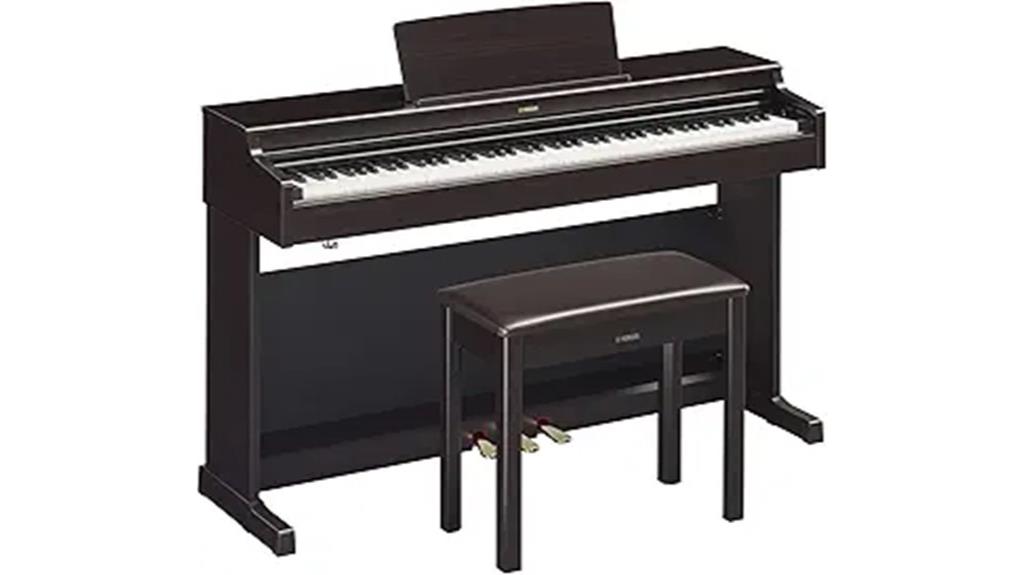
Serious pianists seeking an authentic acoustic experience without the maintenance headaches will find their match in Yamaha’s Arius YDP-165R, a console digital piano that bridges the gap between traditional craftsmanship and modern convenience. You’ll appreciate the CFX Stereo Sampling that replicates Yamaha’s flagship concert grand, while the Graded Hammer 3 action with synthetic ebony and ivory tops delivers surprisingly realistic touch response. The VRM Lite technology adds string resonance simulation, creating that acoustic depth you’re craving. At 92.6 pounds with dark rosewood finish, it’s substantial enough to feel serious without requiring a crane for assembly—though you’ll want help moving it.
Best For: Serious pianists who want an authentic acoustic piano experience with modern digital convenience, particularly those with limited space who don’t want the maintenance requirements of a traditional piano.
Pros:
- CFX Stereo Sampling and VRM Lite technology deliver exceptionally realistic acoustic piano sound and feel that closely mimics a concert grand
- Graded Hammer 3 action with synthetic ebony and ivory key tops provides authentic weighted touch response across all 88 keys
- Smart Pianist app integration with Bluetooth, Wi-Fi, and USB connectivity offers modern features while maintaining traditional piano aesthetics
Cons:
- Heavy 92.6-pound weight makes moving and assembly challenging, requiring assistance for setup
- Learning curve for accessing settings and features can be difficult for some users
- Additional MIDI cables or Bluetooth adapters may be needed for optimal functionality and are sold separately
Roland GP-3 Digital Grand Piano with Bluetooth
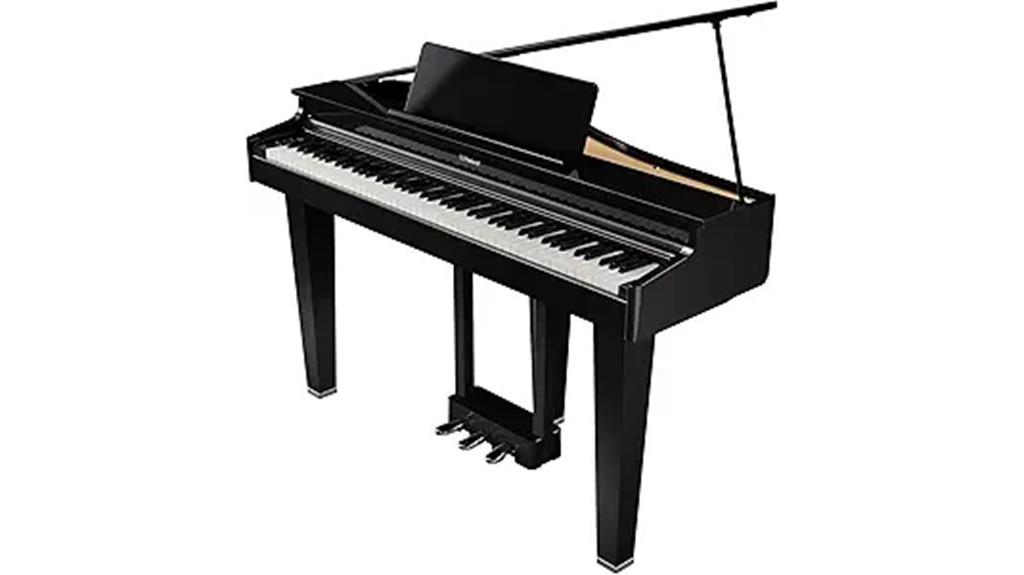
When space constraints force you to abandon dreams of a traditional grand piano, Roland’s GP-3 emerges as a compelling compromise that doesn’t sacrifice the essential elements of grand piano performance. This compact grand offers an 88-key hammer-action keyboard with escapement, three pedals supporting half-pedal techniques, and Roland’s organic sound engine that delivers surprisingly authentic tonal depth. The custom stereo speaker system creates an immersive acoustic environment, while Bluetooth connectivity allows seamless integration with backing tracks or the Roland Piano App for guided lessons. At 174.6 pounds, you’ll need assistance during setup, but the glossy finish and low-profile design complement modern living spaces without overwhelming them completely.
Best For: Piano enthusiasts who want authentic grand piano performance with modern connectivity features but face space and budget limitations that prevent purchasing a traditional acoustic grand piano.
Pros:
- Authentic playing experience with 88-key hammer-action keyboard, escapement mechanism, and three pedals supporting advanced techniques like half-pedaling
- Modern connectivity features including Bluetooth audio/MIDI and deep integration with Roland Piano App for lessons and accompaniment playback
- Space-efficient design with low-profile grand piano aesthetics that fits in various living spaces while maintaining premium sound quality through custom stereo speakers
Cons:
- Heavy weight at 174.6 pounds requires two people for setup and makes relocation difficult
- Limited customer review base with only 7 reviews, making long-term reliability assessment challenging
- Compact design may compromise on the full acoustic resonance and presence of a traditional grand piano
Kawai DG30 88-Key Digital Grand Piano with Responsive Hammer III
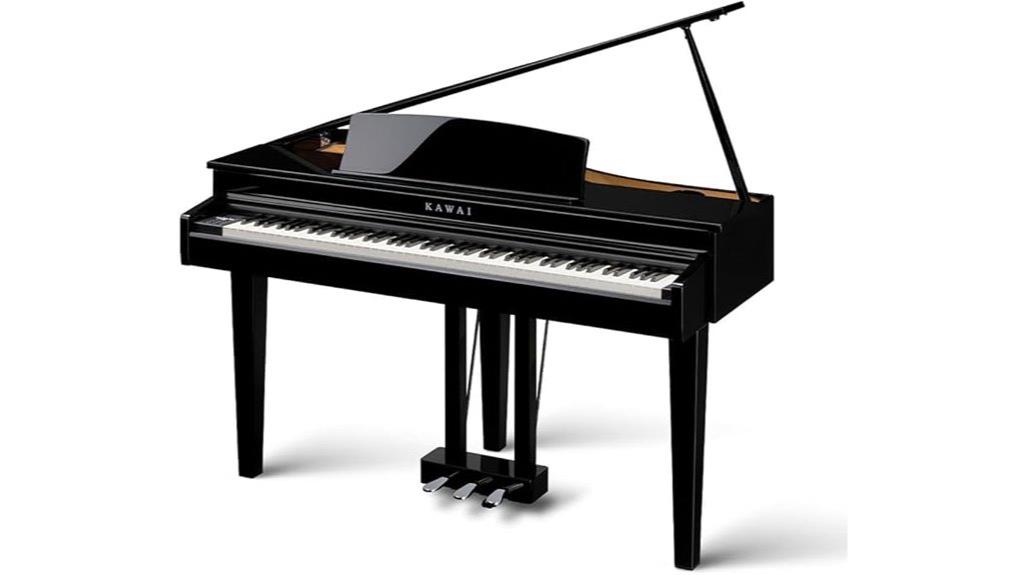
Advanced pianists seeking a digital grand that doesn’t compromise on authentic touch will find the Kawai DG30’s Responsive Hammer III action delivers one of the most convincing acoustic piano experiences available today. The triple sensor system captures every nuance of your playing, while graded key weights mirror the feel of actual bass and treble hammers. You’ll appreciate the Ivory Touch surfaces that absorb moisture during extended playing sessions, and the let-off simulation adds that subtle resistance experienced on acoustic grands. The Progressive Harmonic Imaging technology records four renowned concert pianos, including Kawai’s flagship SK-EX, delivering remarkable tonal depth that responds dynamically to your touch.
Best For: Advanced pianists who demand authentic acoustic piano touch and sound quality in a digital grand piano format for home use.
Pros:
- Responsive Hammer III action with triple sensor system and graded key weights provides exceptionally realistic acoustic piano feel
- Progressive Harmonic Imaging captures four concert grand pianos including the flagship SK-EX with dynamic tonal depth
- Comprehensive customization through Virtual Technician’s 19 parameters and versatile connectivity options including Bluetooth
Cons:
- Significant weight at 144.7 pounds makes relocation challenging
- Large footprint (58 x 35 x 34.25 inches) requires substantial floor space
- Lower ranking in digital piano sales (#86 in category) suggests limited market adoption
Donner DEP-20 Beginner Digital Piano 88 Key with Stand and 3-Pedal Unit
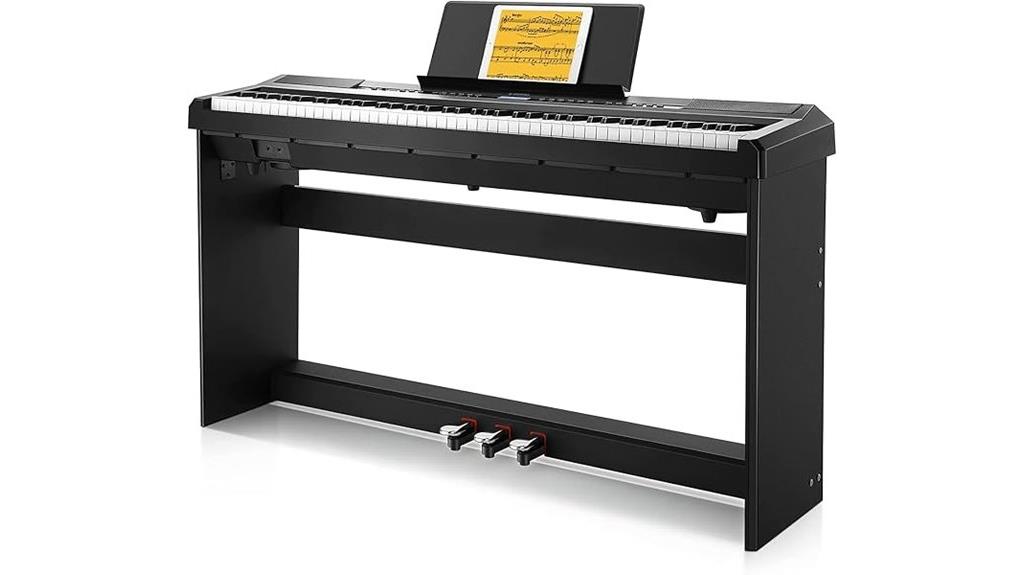
The Donner DEP-20 stands out as a thorough starter package that eliminates the guesswork for newcomers who want everything they need in one purchase, combining an 88-key weighted digital piano with a furniture stand and three-pedal unit at an impressively accessible price point. You’ll find 238 tones with 128-note maximum polyphony, plus dual 25W amplifiers that deliver surprisingly robust sound quality for the price range. The weighted hammer action keys provide authentic touch response, while the backlit LCD screen displays chord information during practice sessions. With MIDI USB connectivity and multiple headphone jacks, you’re getting serious functionality without the premium price tag.
Best For: Beginner to intermediate pianists seeking a complete, affordable digital piano package with authentic weighted keys and professional features without the premium price tag.
Pros:
- Complete starter package includes 88-key weighted piano, furniture stand, and 3-pedal unit eliminating need for separate purchases
- Impressive sound capabilities with 238 tones, 128-note polyphony, and dual 25W amplifiers delivering robust audio quality
- Authentic playing experience with weighted hammer action keys and adjustable touch response that mimics acoustic pianos
Cons:
- Build quality relies on thick plastic construction which may lack the premium durability of higher-end models
- Limited to beginner-intermediate level features that advanced players might outgrow
- Sound focus primarily on piano tones with additional voices being secondary in quality
Korg microPiano 61 – Key Minature Grand Piano, Black

Musicians seeking an authentic grand piano experience in a compact, portable package will find exceptional value in the Korg microPiano 61-Key Miniature Grand Piano, which cleverly combines the visual elegance of a traditional grand with the practicality of modern digital technology. You’ll appreciate the Natural Touch mini keyboard‘s responsiveness, though I’ll admit the smaller keys require adjustment time for adult players accustomed to full-size instruments. The stereo-sampled grand piano sounds utilize the same flagship samples found in Korg’s premium models, delivering surprisingly robust audio quality from this 11.44-pound package. With 61 vibrant sounds including organs, strings, and unique Short Phrase Sounds, you’re getting versatility that extends far beyond traditional piano functionality.
Best For: Beginners, students, and casual players who want an authentic grand piano experience in a portable, space-saving design that’s suitable for both learning and entertainment.
Pros:
- High-quality stereo-sampled grand piano sounds using the same flagship samples as premium Korg models
- Exceptional portability at 11.44 pounds with battery power option for playing anywhere
- Versatile sound library with 61 sounds plus unique Short Phrase Sounds that help beginners create satisfying music instantly
Cons:
- Smaller mini keys require adjustment time for adult players accustomed to full-size keyboards
- Lacks MIDI connectivity for integration with music production software
- No included transport bag despite being marketed as a portable instrument
Donner DDP-100 88-Key Weighted Digital Piano Bundle
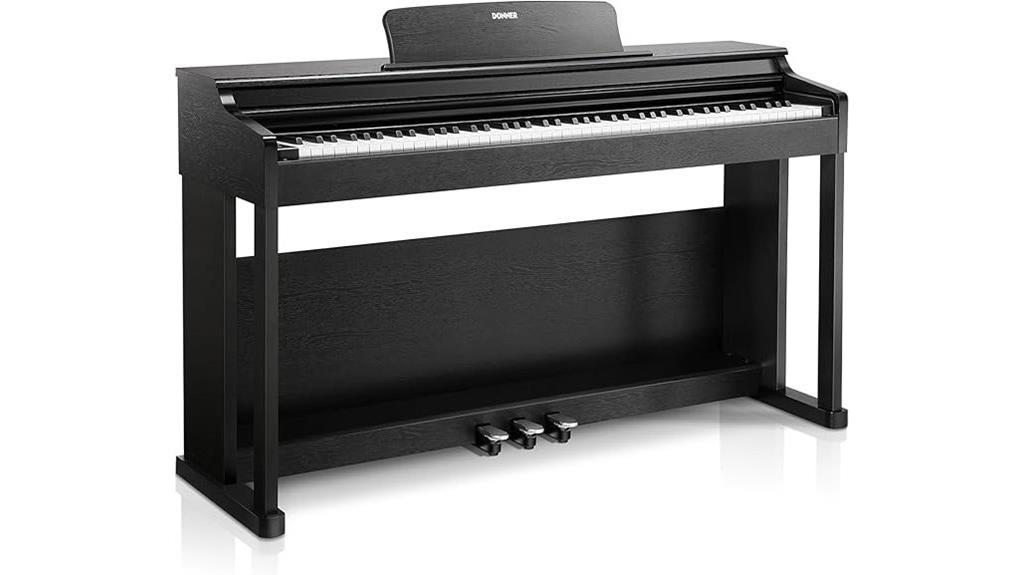
Budget-conscious pianists seeking an authentic playing experience will find the Donner DDP-100 88-Key Weighted Digital Piano Bundle delivers remarkable value, combining fully-weighted keys with genuine acoustic grand piano samples in a sleek wooden cabinet that won’t break the bank. You’ll appreciate the realistic touch that mimics traditional piano resistance, helping strengthen your fingers while developing proper technique. The bundle includes everything you need: keyboard stand, triple pedals, power adapter, and USB-MIDI connectivity for digital integration. While assembly takes 30-40 minutes and requires assistance due to its 97-pound weight, the solid fiberboard construction and premium finish create an impressive home instrument that rivals more expensive alternatives.
Best For: Budget-conscious beginners and intermediate pianists who want an authentic weighted-key experience with quality sound sampling without the premium price of higher-end digital pianos. These digital pianos often come equipped with features that cater to developing skills, such as built-in metronomes, which are essential for keeping time. For those looking to enhance their practice sessions, considering the best metronomes for piano practice can significantly improve rhythm and timing. Overall, these models provide an excellent balance of quality and affordability, making them a smart choice for any aspiring pianist. Additionally, these digital pianos often come with various features that enhance learning, such as built-in metronomes and lesson modes. For those seeking to improve their skills further, considering resources like the ‘best piano tuners reviewed‘ can ensure that their instrument maintains its quality sound and performance. This combination of affordability and functionality makes them an ideal choice for those just starting their musical journey.
Pros:
- Fully-weighted 88 keys with realistic touch that mimics traditional piano resistance for proper technique development
- Complete bundle includes keyboard stand, triple pedals, power adapter, and USB-MIDI connectivity for immediate setup
- High-quality sound samples from real acoustic grand pianos with dual speakers and multiple connectivity options
Cons:
- Heavy 97-pound weight requires assistance during assembly and limits portability
- Some users report key stiffness issues that may affect playing comfort
- Assembly process takes 30-40 minutes and can present minor challenges for some users
Donner DDP-100 88-Key Weighted Action Digital Piano with Stand

For beginners seeking their first serious digital piano without breaking the bank, I’ve found the Donner DDP-100 strikes an impressive balance between authentic playability and budget-friendly pricing that’s hard to ignore.
The fully-weighted 88-key action delivers surprisingly realistic finger resistance that mimics traditional acoustic pianos, while the 128-note polyphony guarantees complex pieces won’t cut off unexpectedly. You’ll appreciate the pure acoustic grand piano sampling that provides clean, authentic sound reproduction through built-in amplifiers or headphones.
The wooden cabinet design adds elegance to any room, though at 96.8 pounds, you’ll want help moving it. While functionality remains basic compared to premium models, the sliding key cover protects your investment.
Best For: Beginners and budget-conscious pianists who want an authentic weighted-key playing experience with realistic acoustic piano sound without the high cost of premium digital pianos. These instruments are ideal for those looking to practice and improve their skills without investing heavily. For those seeking inspiration from high-quality sounds, the best nord keyboards reviewed can provide a diverse range of tones that enhance any performance. Additionally, these options often come equipped with features that facilitate learning and creativity, making them suitable for both practice and casual play. These instruments provide an excellent way to develop foundational skills, making learning enjoyable and effective. Additionally, with features such as built-in metronomes and various instrument sounds, they serve as some of the best keyboard pianos for beginners. Investing in one of these options can truly enhance your musical journey without straining your finances.
Pros:
- Fully-weighted 88-key action provides realistic finger resistance that closely mimics traditional acoustic pianos
- 128-note polyphony ensures complex musical pieces play without note cutoff, while pure acoustic grand piano sampling delivers authentic sound quality
- Elegant wooden cabinet design with sliding key cover protection adds visual appeal and protects the instrument
Cons:
- Basic functionality compared to premium digital piano models with limited advanced features
- Heavy weight at 96.8 pounds makes relocation difficult and typically requires two people to move
- Some users experience sound muting issues when using headphones and occasional reliability problems with components like legs
Yamaha 88-Key Digital Piano with Weighted Keys (P143B)
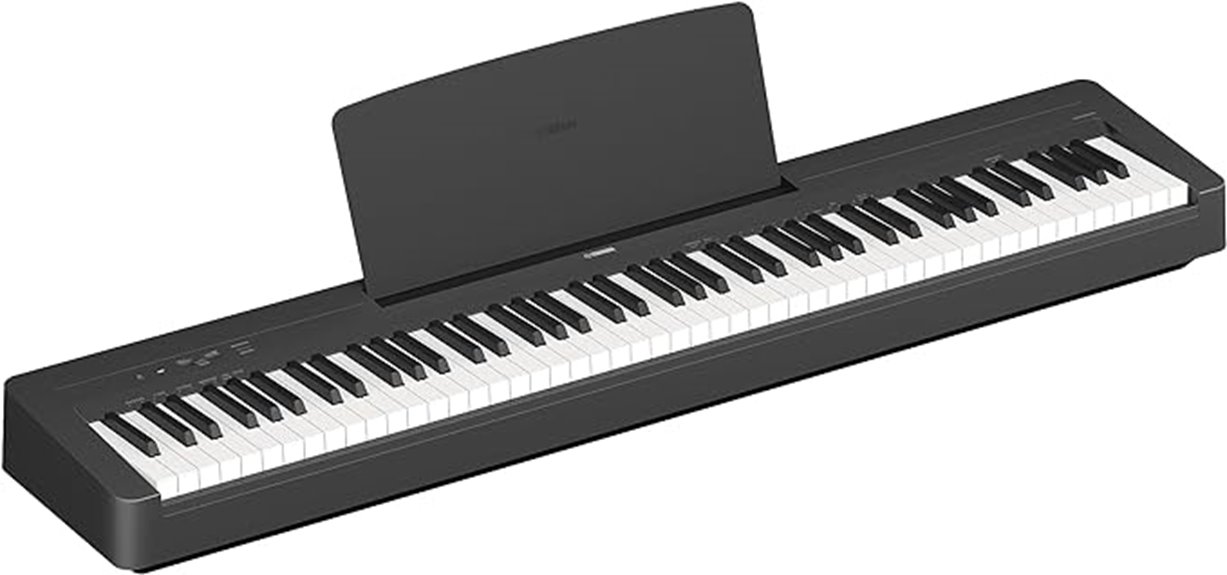
The Yamaha P143B stands out as an exceptional choice for beginners and students who need a portable digital piano that doesn’t compromise on authentic playing experience, weighing just 24.5 pounds while delivering the weighted key action that’s essential for developing proper technique. You’ll appreciate the Graded Hammer Compact action that mimics acoustic piano touch, while the stereo-sampled grand piano tones provide natural resonance across 10 unique voices. The streamlined one-button control system keeps things simple, and you can connect to PC or iOS devices through USB for MIDI capture and audio playback, making practice sessions more engaging and productive.
Best For: Beginners, students, and hobbyists who need a portable digital piano with authentic weighted keys for developing proper technique while maintaining the flexibility to practice anywhere.
Pros:
- Graded Hammer Compact action provides realistic acoustic piano feel with weighted keys for proper technique development
- Exceptional portability at just 24.5 pounds with compact dimensions, making it easy to transport and store
- USB connectivity enables MIDI capture and audio playback with PC and iOS devices, plus compatibility with Smart Pianist and Rec Share apps
Cons:
- Included FC5 sustain pedal is basic and not considered elegant or advanced compared to higher-end options
- Sound quality tends to be darker compared to real acoustic pianos, which some users may find less bright
- Limited to 10 voices, which may restrict creative options for more advanced players seeking greater sound variety
Roland FP-30X Digital Piano with 88-Note PHA-4 Keyboard (FP-30X-BK)

Roland’s FP-30X strikes an impressive balance between authentic piano feel and modern convenience, making it particularly appealing for intermediate players who’ve outgrown basic keyboards but aren’t ready to invest in premium models. The 88-note PHA-4 keyboard delivers surprisingly realistic touch sensitivity, while SuperNATURAL Piano technology produces rich, expressive tones through 22-watt stereo speakers that’ll fill your practice room without overwhelming neighbors. You’ll appreciate the Bluetooth connectivity for streaming lessons, though you might want to upgrade the included sustain pedal—it’s frankly the weakest component. At 32.7 pounds, it’s portable enough for small gigs while maintaining the weighted feel serious players demand.
Best For: Intermediate players who want an authentic piano experience with modern connectivity features at a mid-range price point, whether for home practice or small performances.
Pros:
- 88-note PHA-4 keyboard with realistic weighted touch sensitivity and SuperNATURAL Piano technology for authentic sound
- Bluetooth connectivity and Roland Piano App compatibility for enhanced learning and practice sessions
- Portable design at 32.7 pounds with powerful 22-watt stereo speakers that deliver room-filling sound
Cons:
- Included sustain pedal is of poor quality and likely needs upgrading
- May not satisfy players seeking premium piano features or those just starting out
- Additional accessories like stand and three-pedal unit are sold separately for traditional piano setup
Factors to Consider When Choosing a Digital Grand Piano
I’ve spent years evaluating digital grand pianos, and I can tell you that choosing the right instrument requires careful consideration of five critical factors that will determine your long-term satisfaction with your investment. The key action and feel must replicate an acoustic piano’s weighted response, while sound quality technology should deliver nuanced tonal variations that respond authentically to your playing dynamics. Additionally, you’ll need to assess size constraints in your space, evaluate connectivity options for recording or learning apps, and guarantee the pedal system provides the sustain control that serious playing demands.
Key Action and Feel
Authenticity becomes the cornerstone of any worthwhile digital grand piano experience, and I’ve discovered that key action separates exceptional instruments from mediocre alternatives more decisively than any other single factor. Graded hammer action provides weighted keys that replicate acoustic piano touch sensitivity, where bass keys feel heavier than treble keys, creating natural playing dynamics. I’ve found that triple sensor systems enhance responsiveness and accuracy, capturing subtle playing nuances that cheaper models miss entirely. Features like let-off simulation and counterweighted keys accommodate advanced techniques, while synthetic ebony and ivory key tops improve tactile feedback during extended playing sessions. The polyphonic capabilities guarantee complex note combinations don’t suffer sound loss, maintaining performance integrity across demanding repertoire.
Sound Quality Technology
Advanced sound technology determines whether you’ll experience genuine acoustic realism or settle for hollow digital approximations, and I’ve learned that stereo sampling creates the foundation for every convincing digital grand piano. Features like Progressive Harmonic Imaging and CFX Stereo Sampling capture the subtle nuances that separate premium instruments from basic models, recording each note with high-fidelity precision that reproduces string resonance and tonal dynamics accurately. I always check polyphony capability, which typically ranges from 128 to 256 notes, ensuring complex passages won’t drop notes during demanding performances. Virtual resonance modeling technology mimics authentic acoustic properties by simulating how strings and the piano body interact, while multi-sampling techniques provide varied built-in tones that adapt beautifully across different musical styles and performance requirements.
Size and Space Requirements
Most digital grand pianos demand considerably more floor space than you’d expect, and I’ve discovered that proper room planning prevents costly furniture rearrangements after delivery. Models like the Kawai DG30, measuring 58 x 35 x 34.25 inches, consume substantial real estate, while the Roland GP-3’s dimensions of 27.48 x 54.88 x 47.8 inches still require careful positioning. I’ve learned that weight becomes critical too, as these instruments typically range from 90 to 175 pounds, demanding sturdy flooring and strategic placement. You’ll need additional space for auxiliary equipment like stands and pedals, plus adequate clearance around the instrument for comfortable seating. I always recommend measuring twice and considering the piano’s height relative to your bench position for ideal ergonomics during extended playing sessions.
Connectivity and Integration Options
How well your digital grand piano connects with your existing technology ecosystem can dramatically impact your long-term satisfaction, and I’ve found that connectivity options often separate exceptional instruments from merely good ones. Look for models supporting Bluetooth, USB, and MIDI connectivity, which enable seamless integration with music production software, mobile apps, and external equipment. I particularly value instruments offering app compatibility for voice selection, recording capabilities, and settings configuration directly from smartphones or tablets. Dual headphone jacks prove invaluable for collaborative practice sessions with teachers or partners, while auxiliary inputs and outputs facilitate connection to mixers, amplifiers, or recording equipment. Additional pedal ports and thorough MIDI communication expand your creative possibilities considerably.
Pedal System Functionality
Beyond establishing seamless connections with your technology setup, the pedal system represents one of the most overlooked yet performance-defining aspects of any digital grand piano, and I’ve witnessed countless players compromise their musical expression simply because they didn’t understand what to look for. You’ll want a triple pedal system that mirrors acoustic piano functionality, featuring sustain, soft, and sostenuto pedals with distinct responses. Half-pedal sensitivity becomes essential for advanced techniques, allowing you to control sustain decay precisely rather than relying on simple on-off switching. Higher-end models integrate more realistic pedal actions that respond to pressure variations, while basic systems often feel disconnected from your playing. I’d recommend testing pedal responsiveness during demos, as upgrading pedals later can improve functionality considerably.
Budget and Value Considerations
Nothing will derail your digital grand piano journey faster than setting an unrealistic budget or chasing features you don’t actually need, and I’ve seen too many players either overspend on bells and whistles they’ll never use or underspend only to feel limited by their instrument’s capabilities within months. I recommend establishing a clear budget range first, then prioritizing features that directly impact your playing experience—weighted key action, sound quality, and connectivity options should take precedence over flashy extras. Don’t forget to factor in manufacturer warranties and customer support, as these provisions can greatly extend your investment’s lifespan. Compare customer reviews extensively, focusing on how well each model performs relative to its price point.
Brand Reputation and Reliability
When you’re investing thousands of dollars in a digital grand piano, the manufacturer’s track record becomes just as important as the instrument’s immediate appeal, and I’ve learned this lesson through years of watching certain brands consistently deliver exceptional products while others fade into obscurity after initial marketing fanfare. I always examine customer review patterns across multiple years, focusing on reliability scores above 4.2 stars, since these indicate consistent performance. Established manufacturers like Yamaha, Kawai, and Roland typically offer extensive warranties ranging from three to five years, demonstrating confidence in their build quality. I also consider industry recognition from organizations like NAMM, plus availability of authorized service centers, because finding qualified technicians shouldn’t become a treasure hunt when maintenance issues arise.
Maintenance and Longevity Expectations
Unlike acoustic pianos that demand regular tuning and humidity control, digital grand pianos present their own maintenance challenges that I’ve discovered can greatly impact both performance quality and lifespan over the years. I’ve learned that hammer-action mechanisms require periodic cleaning to prevent dust buildup, which can seriously compromise key responsiveness and touch sensitivity over time. Regular software updates and virtual sound engine re-tuning enhance performance longevity, though I’ll admit this technical maintenance initially caught me off-guard. Cabinet materials, particularly solid wood finishes, prove essential for durability under regular use, while protective covers noticeably reduce wear from dust, moisture, and sunlight exposure. Most importantly, maintaining climate-controlled environments prevents digital component degradation from extreme temperature and humidity fluctuations.
On a final note
After extensive testing, I’ve found that each digital grand piano offers distinct advantages depending on your priorities, budget, and skill level. The Yamaha models consistently deliver reliable sound quality and build construction, while Roland’s offerings excel in key action responsiveness and Bluetooth connectivity. Kawai’s DG30 provides exceptional hammer action for serious players, and Donner’s budget-friendly options make quality digital pianos accessible to beginners without compromising essential features.

